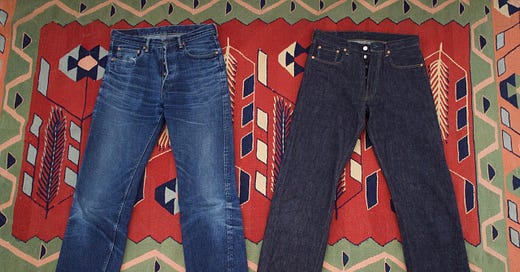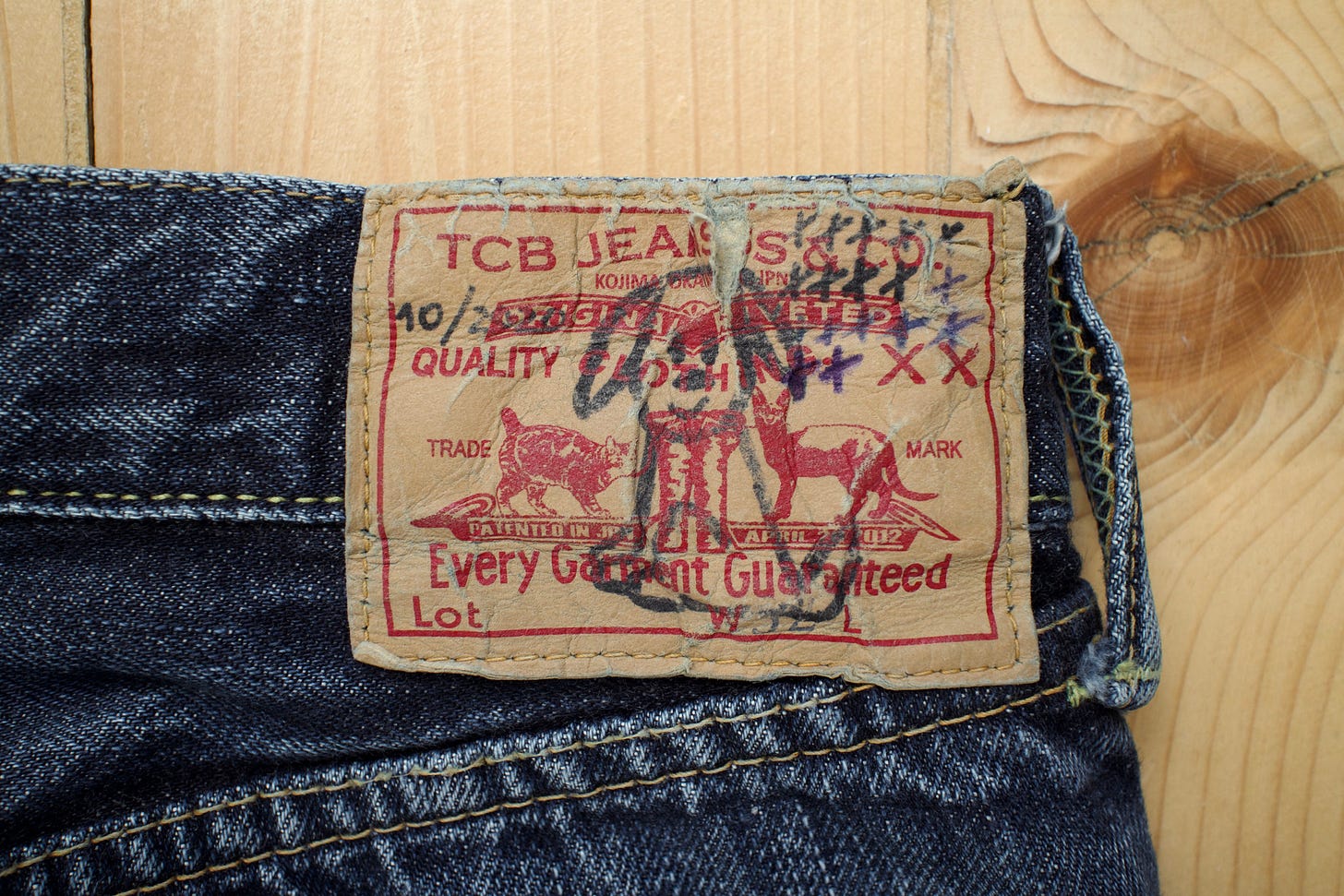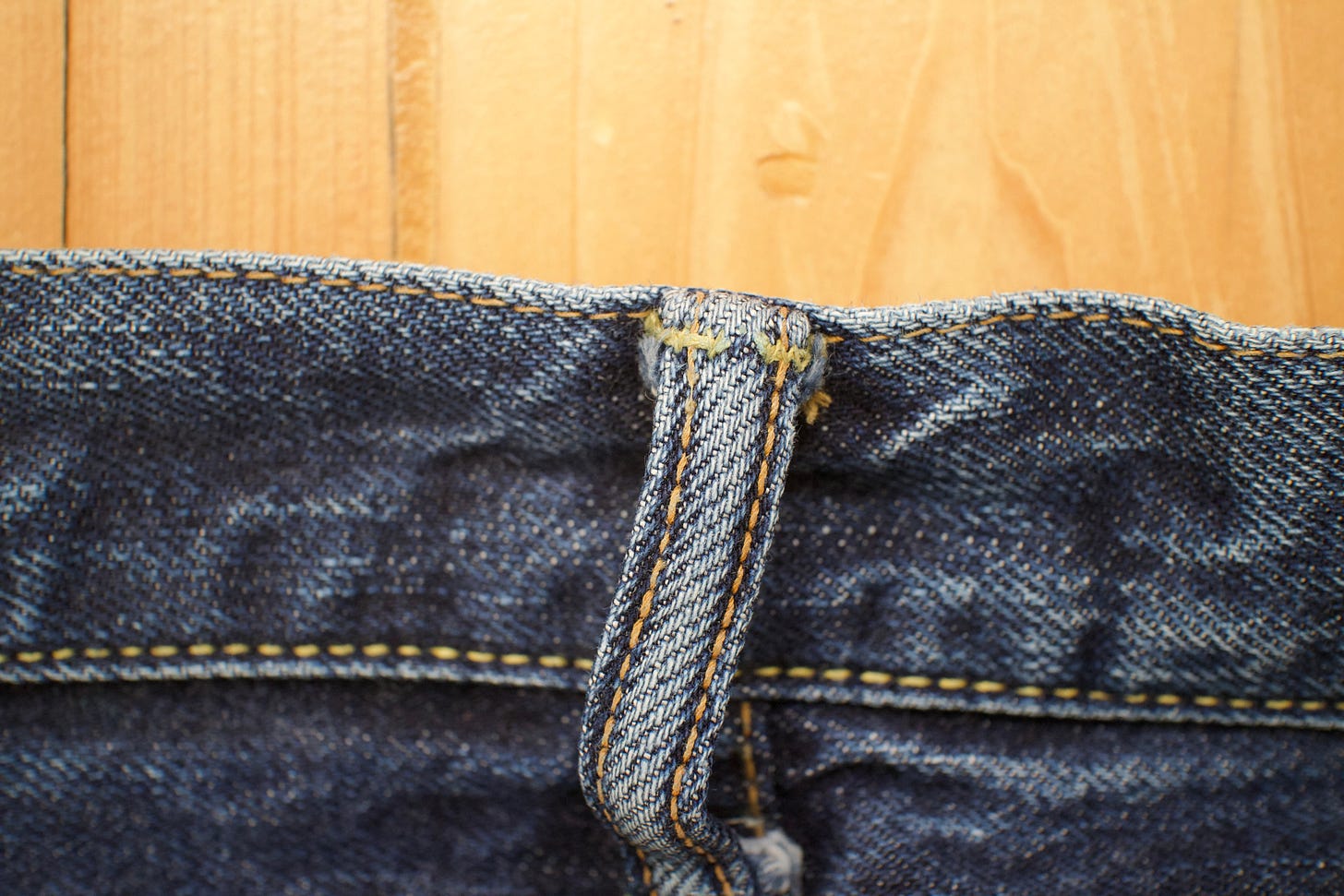This article has been a long time coming. Initially, I intended to write a proper review of my second pair of the TCB 50’s Regular jeans after 250 days of wear. But I didn’t want it to be all praise. Instead, I focused on Things They Don’t Tell You About Raw Denim. With the abundance of talk about superior quality, I wanted to give another perspective on those very things appreciated by jeans enthusiasts. By highlighting the functional drawbacks, I meant to set the right expectations for newcomers who are just considering tapping into raw denim.
But I still love raw denim. Partly, because of the drawbacks I described in the first part. So, the next time I set out to express my fascination with the aging process of raw denim, I ended up writing an article on what I consider to be a true luxury. To achieve one, you have to multiply quality by time and experiences of your own.
Now, quality denim might just be the perfect canvas for building a true luxury. It has a terrific fading potential, meaning its aging will show dramatically over time. It is built strong enough to withstand wear and tear. It adapts to the body and lifestyle, embodying the experiences of its wearer. In this article, I want to show you what it looks like with the help of my second pair of TCB 50’s Regular jeans.
For the record, I have worn the jeans featured in this article 250 times over four years with 17 machine washes. That’s roughly one wash per every 15 wears.
Small ask: If you find this article exciting or helpful, I’d be incredibly grateful if you helped others discover it too. Sharing it with friends, commenting on the blog, or simply hitting ❤️ are all a huge help. Thank you!
Fades
Pictured above are my first (on the left) and second (on the right) pairs of TCB 50’s Regular jeans. They are identical except for the two facts: size and amount of wear. I took these photographs four years ago, right before I started wearing the second pair. By that time, I had worn the pair on the left 250 times over 1.5 years with 10 machine washes. The contrast between the new and worn pairs is tremendous. I admit that natural fades might not be for everyone, and many people even find them gross. Personally, I am constantly amazed by the ongoing transformation of the fabric.
It is not only the contrast that I find fascinating. Notice the richness of the blue shades in the worn pair. It comes from how the quality denim is made. Unlike the white weft yarns that run diagonally on the inside of denim, the surface warp yarns that run vertically on the surface are dyed with indigo. Before dyeing, numerous cotton threads are joined together to form a rope. This way, when dipped into indigo baths, the yarns are only dyed on the outside, while the core remains untouched. The process is well captured in this 3sixteen tour of Kuroki Mills in Japan. With wear and washes, the indigo on the outside of warp yarns gradually fades, revealing the uncolored white core.
However, because jeans are exposed to different amounts of rubbing in different areas, the overall fade is uneven. Look at the knees, for example. With constant bending, they experience more abrasion and thus fade faster. Or the faded creases on the front pocket area, sometimes called whiskers. Or the rectangular fades on the back pockets, resulting from keeping a notebook and a wallet.
When looked up close, the color variation is even richer:
Fades are not only rich in color, they are also unique to each pair. It does sound a bit corny, but there are no two pairs of raw denim jeans with identical fades. Look at how my second pair of the exact same jeans (the new pair in the photographs above) faded differently from the first one:
It does look very similar to the first pair. Yet, it’s still different in details. Notice there is no fade from a notebook on the left back pocket. The fade from a wallet on the right back pocket is less contrasty because I washed the second pair almost twice as often as the first one, and the overall fade is more uniform.
This uniqueness in fade doesn’t make raw denim necessarily better than industrially faded jeans. But the process of transformation from a uniform dark indigo color into uniquely faded blue jeans does give them a character and essentially makes them alive. A key component that makes up a piece of clothing a true luxury.
Small ask: If you find this article exciting or helpful, I’d be incredibly grateful if you helped others discover it too. Sharing it with friends, commenting on the blog, or simply hitting ❤️ are all a huge help. Thank you!
Leg Twist
This one is funny. Did you notice anything weird in the faded pairs above? Look at the side seams of the legs. The legs literally twisted!
I find it hard to explain my excitement about this phenomenon. Overall, just like fades, a leg twist adds up to the uniqueness of a worn pair of raw denim jeans. But there is more to it.
The leg twist appears because of how denim is woven. Remember the weft yarns on the inside of denim? Because they run diagonally, they make denim twist over time. The thing is that most denim used in mass-produced jeans is industrially processed to minimize shrinking and leg twist with wear and washing. It’s more convenient for consumers this way as they don’t have to account for the amount of potential shrinking when purchasing a new pair. And the shrinkage is real.
The price of such convenience? By passing a part of the natural aging process on to industrial machines, we are giving away the opportunity to imprint our own character into a pair of jeans. Having to think about sizing is indeed an extra burden. But it is also a chance to build bonds between an item and its owner. There will be misses in sizing sometimes. But they only make hits even more valued.
One last thing about the leg twist is that it’s bizarre, yet subtle. It reminds me of those mismatched footwear collaborations the New York brand Engineered Garments has become known for. The strangeness is there, and it’s weird. But most people won’t notice. It is an easter egg, and you are the only one in the room knowing about it. It’s amusing to get away with it.
Blowouts
Yes, I have irrational feelings for raw denim because of the way it tears. It is one thing when a button falls off because it was shabbily attached in the first place. Or a fabric holes after a year of occasional wear. There is no beauty in poor quality.
But it’s a whole other story when you have been wearing a pair of raw denim for years, and the hidden rivets holding back pockets finally show through. Or the cardboard patch cracks after numerous washes. Even the threads holding the front pocket bags fall apart because they are made out of cotton instead of stronger synthetic fibers.
Some blowouts are more critical than others. The cracked cardboard patch doesn’t affect the wearability of the jeans. However, the worn-out threads holding the pocket bags make the front pockets no longer functional. My phone has already slipped through the leg a few times, and I wear the jeans less and less.
But even the harshest of blowouts can be repaired. Some people are capable of doing repairs themselves. I believe it’s the ultimate way to bond with an item. I tried it a few times in the past. While it did receive some recognition, the time-to-quality ratio could have been better. Now I dream of bringing my pairs to a professional like Arthur Leclercq of Superstitch. Although expensive, the way he handpicks tonal threads to do invisible repairs is just insane. But honestly, any method works as long it gets the job done. It all adds up to the character.
Small ask: If you find this article exciting or helpful, I’d be incredibly grateful if you helped others discover it too. Sharing it with friends, commenting on the blog, or simply hitting ❤️ are all a huge help. Thank you!
Roping
Technically, roping is fade, too. Along with whiskers and honeycombs, it’s one of the most sought-after fade patterns. A very special one, if you ask me. Roping appears at the leg opening due to the slight tension created in the bent fabric during hemming. Because of this tension, the bent fabric puckers, forming a sort of wave running through it. The raised part of the wave experiences more abrasion and thus fades faster. The lower part of the wave, on the contrary, retains a dark indigo shade longer. The contrast between the two forms a three-dimensional visual effect along the hem.
The shape of the wave highly depends on hemming. Some puckering appears to be vertical or parallel to the inseam. Others are twisted just enough to remind a coveted rope. Denim enthusiasts still debate about what exactly causes the twisting. A common belief is that originally, it was triggered by the innate flaw in the Union Special 43200G hemming machine used by the major American brands, including Levi’s in the mid-20th century. Others argue that such twisting might be achieved by any sewing machine as long as you misalign the seams on the outside and underside of the hem.
I owned jeans from different brands that claim they hem their jeans with Union Special machine. But the roping pattern was always different. What I did notice though is that pre-distressed jeans by non-specialized denim brands tend to feature less-pronounced, blurry vertical patterns. Hence, true roping might be yet another differentiator of your faded pair of proper raw denim that no one will ever notice. You do it for yourself.
Conclusion
This article completes my series on raw denim. I started with setting up expectations by highlighting Things They Don't Tell You About Raw Denim. I then derived the concept of a true luxury to back up my love for the subject. Hopefully, with this article, I was able to express this love in detail.
That doesn’t mean I will stop writing about denim though. I recently started a new pair of 3sixteen RS-100x jeans and I will continue updating you on the progress. I have a few even more niche things to say about my three pairs of TCB 50s Regular jeans.
What keeps you excited about raw denim? Or maybe stops you from tapping into it?
If you have any questions or feel like something is missing, please don't hesitate to ask in the comments section of this article. I'm here to help! 🙌
I would greatly appreciate it if you could hit a ❤️ and restack the article here on Substack or share it on your social media to help others discover it too.
And if you would like further reading, here is a selection of some of my favorite articles:















god i love denim and god do i love raw denim
What are the handmade crosses on the carton patch? Did you mark the times you washed your jeans?! Haha I love it! And this article is an ode to beautiful fabric. Well done.